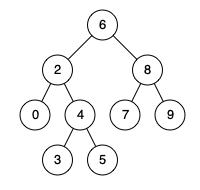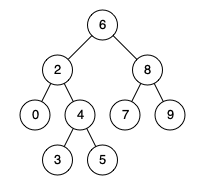Start now! 🚀🚀
Problem 🤔
Given a binary search tree (BST), find the lowest common ancestor (LCA) of two given nodes in the BST.
According to the definition of LCA on Wikipedia: “The lowest common ancestor is defined between two nodes p and q as the lowest node in T that has both p and q as descendants (where we allow a node to be a descendant of itself).”
Example 1

Input: root = [6,2,8,0,4,7,9,null,null,3,5], p = 2, q = 8
Output: 6
Explanation
The LCA of nodes 2 and 8 is 6.
Example 2

Input: root = [6,2,8,0,4,7,9,null,null,3,5], p = 2, q = 4
Output: 2
Explanation
The LCA of nodes 2 and 4 is 2, since a node can be a descendant of itself according to the LCA definition.
Example 3
Input: root = [2,1], p = 2, q = 1
Output: 2
Constraints
- All nodes are unique
p != qpandqwill exist in the BST
Real World Applications 🌎
Looking at a family tree? This is a super helpful function for any data representation that has a lineage!

Recursive Solution 💡
As we’ve seen for countless other tree problems, a recurisve solution often lets us write elegant and concise code, especially when dealing with traversals. Let us start off with this approach.
1) If the root is either p or q, since we are promised that both nodes are present we know that the other node is definitley in the subtree! We can call it a day.
2) How do we recurse the rest of the tree? Let’s think about what our recursion should do. A helpful recursive function would return the null if p and q are not in the tree. Otherwise, it can return a pointer to our node :) We can run this check on our left and right subtrees respectively.
Complexity Analysis 🧮
Time Complexity
Run time: O(n)
Traverse all nodes in the tree once.
Space Complexity
O(n)
Unbalanced bst will require recursing on every node. A height balanced bst will require O(log(n)).
The Finer Details 🔎
Let’s define a divergent point as the first node in the tree where there is a split and p and q belong to different subtrees. We want to traverse down the tree to the earliest divergent point. We can use the fact that bst is … sorted and do this efficiently!
Optimal Solution - Iteratively 💡
Complexity Analysis 🧮
Time Complexity
Run time: O(n)
Visit every node in the tree once, worst case.
Space Complexity
O(1)
Only constant helper variables declared.
Takeaways 🎉🥳
- Break down the recursion into smaller digestible steps, before concerning yourself with implementation details.
- Lowest common ancestor problems will always look for the divergent point! This is a key insight, and makes the iterative version easier to understand.
Resources 📚
- Cracking the Coding Interview, 4.8 First Common Ancetor (Note, here we have a BST and not binary tree)
Related Posts 18
Quick Links
Legal Stuff
